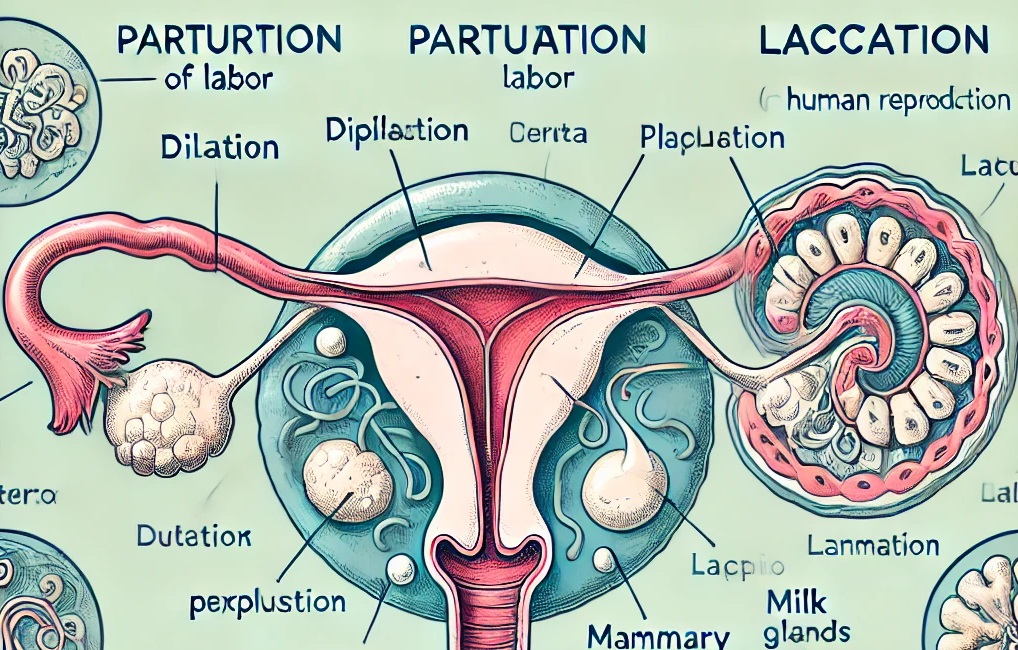
Parturition and Lactation Human Reproduction
Parturition and lactation are two essential processes in human reproduction that occur at the end of pregnancy. Parturition refers to the process of childbirth, while lactation involves the production of breast milk to nourish the newborn. These processes are intricately regulated by hormones and play a vital role in ensuring the survival and well-being of the infant.
Parturition: The Process of Childbirth
Parturition is the medical term for childbirth, which involves the delivery of the baby and the placenta from the mother’s womb. This complex process is divided into three main stages: the dilation stage, the expulsion stage, and the placental stage. The onset of parturition is triggered by hormonal signals that prepare both the mother’s body and the baby for delivery.
1. Hormonal Control of Parturition
The birth process is primarily regulated by hormones. As the pregnancy nears full term, a series of hormonal changes signal the body to prepare for labor:
- Oxytocin: This hormone is produced by the hypothalamus and released by the pituitary gland. It plays a crucial role in stimulating uterine contractions during labor. Oxytocin also promotes emotional bonding between the mother and baby after birth.
- Estrogen: Toward the end of pregnancy, estrogen levels increase, leading to the softening of the cervix and making it easier for the baby to pass through the birth canal.
- Progesterone: Although this hormone supports pregnancy by preventing contractions, its levels decrease just before labor, allowing the uterus to contract more easily.
- Prostaglandins: These chemicals are produced by the placenta and the uterus and help to further soften the cervix and stimulate contractions.
2. Stages of Labor
Labor is divided into three distinct stages, each serving an essential role in the birthing process.
- First Stage: Dilation of the Cervix
This stage begins with the onset of regular contractions and ends when the cervix is fully dilated (10 cm). It is the longest stage of labor and can last from a few hours to more than a day for first-time mothers. The contractions help to thin and open the cervix, allowing the baby to move into the birth canal.- Early Labor: Contractions are mild and irregular, and the cervix dilates slowly.
- Active Labor: Contractions become stronger, longer, and closer together, leading to faster dilation of the cervix.
- Transition: This is the final part of the dilation stage, where contractions are most intense, and the cervix dilates from 7 cm to 10 cm.
- Second Stage: Expulsion of the Baby
The second stage begins when the cervix is fully dilated and ends with the birth of the baby. During this stage, the mother pushes in response to the contractions, and the baby moves through the birth canal. The expulsion of the baby can take anywhere from a few minutes to a few hours, depending on factors like the position of the baby and whether it’s the mother’s first childbirth. - Third Stage: Delivery of the Placenta
After the baby is born, the placenta, which has provided nutrients and oxygen to the baby during pregnancy, must be delivered. This stage usually lasts about 10-30 minutes. Uterine contractions continue, helping to detach the placenta from the uterine wall. Oxytocin is also released in higher amounts to reduce bleeding by causing the uterus to contract more firmly.
3. Postpartum Period
Once the baby and placenta are delivered, the postpartum period begins. This is a time of recovery for the mother, as the uterus gradually returns to its pre-pregnancy size, and the body prepares for the next phase: lactation.
Lactation: Breastfeeding the Newborn 🍼
Lactation refers to the production and secretion of breast milk by the mammary glands, which nourishes the newborn. This process begins after childbirth when the hormones that supported pregnancy give way to those that encourage milk production and release.
1. Hormonal Control of Lactation
- Prolactin: This hormone, secreted by the anterior pituitary gland, stimulates the mammary glands to produce milk. Its levels increase significantly after childbirth, especially when the baby suckles at the breast, signaling the body to produce more milk.
- Oxytocin: Oxytocin is responsible for the milk let-down reflex, which causes the milk to flow from the mammary glands into the milk ducts, making it available to the baby. Oxytocin is also the hormone responsible for emotional bonding between the mother and child during breastfeeding.
- Progesterone and Estrogen: During pregnancy, these hormones prepare the breast tissue for milk production. After delivery, their levels drop sharply, allowing prolactin and oxytocin to take over the process of milk secretion.
2. Milk Production and Types of Breast Milk
Breast milk provides complete nutrition for the baby during the first six months of life and adapts to the baby’s changing needs. There are three types of breast milk produced during lactation:
- Colostrum: This is the first milk produced in the first few days after childbirth. It is thick, yellowish, and packed with antibodies and immune-boosting substances that protect the newborn from infections. Although the volume is small, colostrum is extremely nutrient-dense and crucial for the baby’s health.
- Transitional Milk: Around 2-5 days postpartum, colostrum gradually transitions into transitional milk. This milk is more abundant and has a higher fat and calorie content, supporting the baby’s rapid growth in the first few weeks.
- Mature Milk: By the second week postpartum, mature milk is produced. This milk contains the right balance of fats, proteins, carbohydrates, vitamins, and minerals required for the baby’s continued growth and development. It is composed of two parts:
- Foremilk: The milk that is released at the beginning of a feeding session, which is more watery and helps to quench the baby’s thirst.
- Hindmilk: The milk that comes later in the feeding, which is richer in fats and calories, helping the baby gain weight.
3. Benefits of Breastfeeding
Breastfeeding offers a range of benefits for both the mother and the baby:
- For the baby:
- Provides essential nutrients and antibodies that protect against infections.
- Lowers the risk of asthma, allergies, and obesity later in life.
- Promotes healthy brain development and cognitive skills.
- For the mother:
- Helps the uterus contract and return to its normal size more quickly after birth.
- Reduces the risk of breast and ovarian cancers.
- Promotes bonding with the baby through the release of oxytocin.
4. Challenges and Support in Breastfeeding
While breastfeeding is natural, it can come with challenges such as:
- Latching difficulties: Some babies may have trouble latching onto the breast correctly, causing discomfort or inadequate milk transfer.
- Low milk supply: This can occur due to various factors such as stress or medical conditions, but frequent nursing or expressing milk can help increase supply.
- Sore nipples or breast infections: Conditions like mastitis (infection of breast tissue) or cracked nipples can make breastfeeding painful. Seeking help from a lactation consultant can provide relief and guidance.
Many mothers benefit from support groups, lactation consultants, and healthcare professionals to navigate these challenges and ensure successful breastfeeding.
See in Fig:

10 Questions and Answers about Parturition and Lactation in Human reproduction,
1. Question: What is parturition?
- Answer: Parturition is the process of childbirth, where the fetus is expelled from the mother’s uterus.
- Explanation: Parturition marks the end of pregnancy and is initiated by a complex hormonal signaling process, mainly involving oxytocin and prostaglandins, which stimulate uterine contractions.
2. Question: Which hormone plays a key role in stimulating uterine contractions during labor?
- Answer: Oxytocin.
- Explanation: Oxytocin is released by the pituitary gland and causes the muscles of the uterus to contract, aiding in the expulsion of the fetus. It is often called the “birth hormone” because of its critical role in labor.
3. Question: What is the role of prostaglandins in parturition?
- Answer: Prostaglandins help to soften and dilate the cervix and stimulate uterine contractions.
- Explanation: Prostaglandins are produced by the placenta and fetal membranes. They prepare the cervix for delivery and promote uterine contractions, which are necessary for the progression of labor.
4. Question: What is the term for the initial release of milk from the mammary glands after childbirth?
- Answer: Colostrum.
- Explanation: Colostrum is the first form of milk produced by the mammary glands immediately following birth. It is rich in antibodies and nutrients, providing essential immunity to the newborn.
5. Question: Which hormone is responsible for milk production in the mammary glands?
- Answer: Prolactin.
- Explanation: Prolactin is produced by the anterior pituitary gland and stimulates the mammary glands to produce milk. Its levels increase during pregnancy and reach a peak during lactation.
6. Question: What triggers the release of prolactin and oxytocin during breastfeeding?
- Answer: The suckling reflex.
- Explanation: When the baby suckles at the breast, nerve signals are sent to the brain, stimulating the release of prolactin and oxytocin. Prolactin stimulates milk production, while oxytocin causes the milk ejection reflex (let-down).
7. Question: How does estrogen affect the mammary glands during pregnancy?
- Answer: Estrogen stimulates the growth and development of the ductal system in the mammary glands.
- Explanation: During pregnancy, estrogen levels rise, promoting the growth of the ducts in the mammary glands to prepare for milk secretion.
8. Question: What changes occur in the uterus after childbirth?
- Answer: The uterus undergoes a process called involution, where it shrinks back to its pre-pregnancy size.
- Explanation: Involution is facilitated by the hormone oxytocin and involves the gradual shrinking of the uterine muscle, as well as the shedding of the uterine lining.
9. Question: What is the main purpose of colostrum?
- Answer: To provide the newborn with immunity and essential nutrients.
- Explanation: Colostrum contains high levels of antibodies, particularly immunoglobulin A (IgA), which protect the newborn against infections. It also has a high concentration of proteins, vitamins, and minerals.
10. Question: Which hormone inhibits milk production during pregnancy despite high levels of prolactin?
- Answer: Progesterone.
- Explanation: Although prolactin levels increase during pregnancy, high levels of progesterone inhibit milk production. After childbirth, progesterone levels drop, allowing prolactin to initiate lactation.






